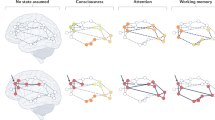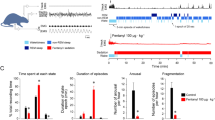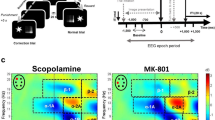Abstract
Previous research on the behavioural functions of endogenous opioid systems in rodents suggested a possible opioid role in the regulation of attention1,2. This proposal was consistent with reports that opiate administration in man impairs the ability to concentrate3 while opiate antagonists augment behavioural4 and electrophysiological5 indices of arousal and attention. We examined the effects of the opiate antagonist naloxone on electrophysiological measures of attention in normal human subjects, using a paradigm which dissociates selective information processing from concurrent processes of general arousal or alertness that may be present6. We now report electrophysiological evidence that naloxone improves the selectivity of auditory attention in the presence of competing sources of stimuli. These findings indicate a role for the endogenous opioid systems in the regulation of selective attention in man.
This is a preview of subscription content, access via your institution
Access options
Subscribe to this journal
Receive 51 print issues and online access
$199.00 per year
only $3.90 per issue
Buy this article
- Purchase on Springer Link
- Instant access to full article PDF
Prices may be subject to local taxes which are calculated during checkout
Similar content being viewed by others
References
Arnsten, A. T. & Segal, D. S. Life Sci. 25, 1035–1042 (1979).
Arnsten, A. F. T., Segal, D. S., Loughlin, S. E. & Roberts, D. C. S. Brain Res. 222, 351–363 (1981).
Jaffe, J. H. & Martin, J. R. in The Pharmacological Basis of Therapeutics 6th edn (eds Gilman, A. G., Goodman, L. S. & Gilman, A.) 494 (Macmillan, New York, 1980).
Gritz, E. R., Shiftman, S. M., Jarvik, M. E., Schlesinger, J. & Charuvastra, V. C. Clin. Pharmac. Ther. 19, 773–776 (1976).
Davis, G. C., Buchsbaum, M. S. & Bunney, W. E. in Neutral Peptides and Neuronal Communications (eds Costa, E. & Trabucchi, M.) 473 (Raven, New York, 1980).
Hillyard, S. A., Hink, R. F., Schwent, V. L. & Picton, T. W. Science 182, 177–180 (1973).
Schwent, V. L., Snyder, E. & Hillyard, S. A. J. exp. Psychol: Hum. Perception Performance 2, 313–325 (1976).
Parasuraman, R. Psychophysiology 15, 460–465 (1978).
Naatanen, R. & Michie, M. T. Biol. Psychol. 8, 81–136 (1979).
Hansen, J. & Hillyard, S. A. Electroenceph. clin. Neurophysiol. 49, 277–290 (1980).
Hink, R. F., Van Voorhis, S., Hillyard, S. A. & Smith, T. S. Neuropsychologia 15, 597–605 (1977).
Okita, T. Biol. Psychol. 9, 271–284 (1979).
Lewis, M. E. et al. Science 211, 1166–1169 (1981).
Wise, S. P. & Herkenham, M. Science 218, 387–389 (1982).
Knight, R. T., Hillyard, S. A., Woods, D. L. & Neville, H. Electroenceph. clin. Neurophysiol. 50, 112–124 (1980).
McGinty, J. F., van der Kooy, D., Koda, L. Y. & Bloom, F. E. Anat. Rec. 202, 125a (1982).
Author information
Authors and Affiliations
Rights and permissions
About this article
Cite this article
Arnsten, A., Segal, D., Neville, H. et al. Naloxone augments electrophysiological signs of selective attention in man. Nature 304, 725–727 (1983). https://doi.org/10.1038/304725a0
Received:
Accepted:
Published:
Issue Date:
DOI: https://doi.org/10.1038/304725a0
This article is cited by
-
Naltrexone improves learning and attention in self-injurious individuals with developmental disabilities
Journal of Developmental and Physical Disabilities (1993)
-
Emotional numbing: A possible endorphin-mediated phenomenon associated with post-traumatic stress disorders and other allied psychopathologic states
Journal of Traumatic Stress (1992)
-
An hypothesis on the role of glucose in the mechanism of action of cognitive enhancers
Psychopharmacology (1989)
-
Fragments of ACTH affect electrophysiological signs of controlled stimulus processing in humans
Psychopharmacology (1989)
-
Improved recognition memory in monkeys following naloxone administration
Psychopharmacology (1988)
Comments
By submitting a comment you agree to abide by our Terms and Community Guidelines. If you find something abusive or that does not comply with our terms or guidelines please flag it as inappropriate.



